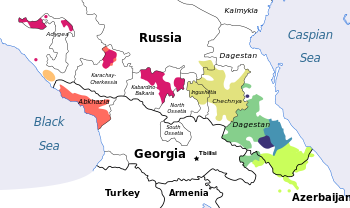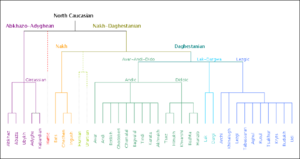- North Caucasian languages
-
North Caucasian Caucasic Geographic
distribution:Caucasus Linguistic classification: proposed language family, which is widely disputed; although links with other families have been proposed, none of these has received mainstream acceptance Subdivisions: ISO 639-5: ccn 
North Caucasian languagesWest Caucasian
CircassianAbkhazUbykh (extinct)East Caucasian
NakhAvar-Andi and TsezicDarginLakLezgic and KhinalugNorth Caucasian languages (sometimes called simply Caucasic as opposed to Kartvelian, and to avoid confusion with the concept of "Caucasian race") is a blanket term for two language phyla spoken chiefly in the north Caucasus and Turkey: the Northwest Caucasian family (Pontic, Abkhaz–Adyghe, Circassian, West Caucasian) and the Northeast Caucasian family (Caspian, Nakh–Dagestanian, East Caucasian); the latter includes the former North-central Caucasian (Nakh) family.
Many linguists, notably Sergei Starostin and Sergei Nikolayev, believe that the two groups sprang from a common ancestor about five thousand years ago.[1] However, this proposal is difficult to evaluate, and remains controversial.
There are approximately 34 to 38 distinct living or extinct North Caucasian languages.[2]
Contents
Internal classification
Among the linguists who support the North Caucasian hypothesis, the main split between Northeast Caucasian and Northwest Caucasian is considered uncontroversial. Problems arise when it gets to the internal structure of Northeast Caucasian itself. So far no general agreement has been reached in this respect. The following classification is based on Nikolayev & Starostin (1994):
- Abkhazo-Adyghean
- Hattic
- Nakh–Daghestanian
- Nakh
- Hurro-Urartian
- Daghestanian
- Avar–Andi–Dido
- Lak–Dargwa
- Lezgic
 North Caucasian Family Tree (Nikolayev & Starostin 1994)
North Caucasian Family Tree (Nikolayev & Starostin 1994)
 Glottochronological Model (reference?)
Glottochronological Model (reference?)
Comparison of the two phyla
The main perceived similarities between the two phyla lie in their phonological systems. However, their grammars are quite different.
Main similarities
Both phyla are characterised by high levels of phonetic complexity, including the widespread usage of secondary articulation. Ubykh (Northwest) has 84 consonants, and Archi (Northeast) is thought to have 76.
A list of possible cognates has been proposed. However, most of them may be loanwords or simply coincidences, since most of the morphemes in both phyla are quite short (often just a single consonant).
Main differences
The Northeast Caucasian languages are characterised by great morphological complexity in the noun. For example, in Tsez, a series of locative cases intersect with a series of suffixes designating motion with regard to the location, producing an array of 126 locative suffixes (often – depending on the analysis – described as noun cases).
By contrast, the Northwest Caucasian noun systems are relatively poor in morphology, usually distinguishing just two or three cases. However, they make up with a very complex verbal structure: the subject, the direct object, the indirect object, benefactive objects and most local functions are expressed in the verb.
Some comparisons
Personal pronouns[3] Person Northeast Caucasian[4] PNWC[1] PNC[1] PN PDL PLK PAAT PNEC 1 *su- *du *zʷə- dVpal *zʷə- *sA *zoː 2 *ħu- *ħʷə *ʁʷə- dVlab/mV *ʁʷə- *wA *u̯oː/*ʁwVː 4i *way[5] *-χːa *χːə- *iλiː *łiː- (?) *šʲə/tːa/χːa[6] *Läː 4e *tχu-[7] *žu *žʲə *išiː *z⇨ʲə- *ži 5 *šu- *-šːa/zu *žʷə *bišːdi *z⇨ʷə- *sʷV *źwe Abbreviations: PN = Proto-Nakh, PDL = Proto-Dargi-Lak, PLK = Proto-Lezgic-Khinalugh, PAAT = Proto-Avar–Andic–Tsezic, PNEC = Proto-Northeast Caucasian, PNWC = Proto-Northwest Caucasian, PNC = Proto-North Caucasian
Number PNEC (S) PNEC (N) PNWC (S) PNWC (C) PNC 1 *c(h)a #c(ʕ)V *za *cHǝ̆ 2 *qʷ’a *t’qʷ’a *t’q’o *q̇Hwǟ 3 *ɬeb (?) *λ:ə *(y-)x̂ə/a *ƛHĕ 4 *əmq(ʷ)’i *p’λ’a *hĕmq̇ɨ 5 *x̂ʷə #(W)=ƛƛi/ƛƛwi *sx̂ʷə *(w-/y-)ćx̂ə *f_ɦä̆ 6 *renɬə- *ɬʷə *(w-)x̂cə *ʔrǟnƛ_E 7 *u̯ərδ (?) *bδə *ʡĕrŁ_ɨ̆ 8 *mbərδ --- *(w-/y-)ɣə/a *bǖnŁ_e (˜-a) 9 *wərč’ *bğʷʲə *-ɣə́ *ʔĭlć̣wɨ 10 *wəc’ *bć’ʷə *(p-/w-)źə́/źá *ʡĕnc̣Ĕ Abbreviations: (N) = Nichols, (S) = Schulze, (C) = Colarusso
Criticism
Not all scholars accept the unity of the North Caucasian languages, and some who do believe that the two are, or may be, related do not accept the methodology used by Nikolayev and Starostin.[8]
See also
References
- ^ a b c Nikolayev, S., and S. Starostin. 1994 North Caucasian Etymological Dictionary. Moscow: Asterisk Press. Available online.
- ^ Ethnologue report on the North Caucasian group
- ^ PN = Proto-Nakh, PDL = Proto-Lak-Dargwa, PLK = Proto-Lezghian-Khinalug, PAAT = Proto-Avar-Andi-Tsezic, PNEC = Proto-Northeast Caucasian, PNWC = Proto-Northwest Caucasian, PNC = Proto-North Caucasian
- ^ Wolfgang Schulze 2007 [1996]. Personalität in den ostkaukasischen Sprachen. (190 pp.). Munich Working Papers in Cognitive Typology
- ^ Schulze considers this to be a loanword from Proto-Indo-European
- ^ Ubykh/Proto-Adyghe–Kabardian/Proto-Abkhaz–Tapant. These forms are difficult to reconcile.
- ^ Probably the original 1st plural inclusive.
- ^ Nichols, J. 1997 Nikolaev and Starostin's North Caucasian Etymological Dictionary and the Methodology of Long-Range Comparison: an assessment Paper presented at the 10th Biennial Non-Slavic Languages (NSL) Conference, Chicago, 8–10 May 1997.
Categories:- Proposed language families
Wikimedia Foundation. 2010.
